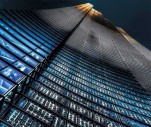Heron Tower: Symbiosis of Conservatism and Innovations

High-tech is one of contemporary architectural styles matching to highrise construction best of all. It combines the pragmatism of the rational approach to the use of the modern designs and materials, progressionism, etc., as well as graphic intensity and artistic expressiveness that achieved by means of visual emphases on the building exterior. Being in stark contrast to eclecticism, where the structural basis of the building is virtually “dressed” in the attributes of the style, High-tech looks like absolutely honest architecture that wins favor by means of its visual transparency and compositional clarity. Its brevity and supremacy (symbiosis) of the functional approach and the artistic source are the key elements to the popularity of the style. Emerged in the 1970 – 1980’s, it continues to successfully develop in high-rise construction, formost than in any other branch. In a sense, it is more convenient from the functional point of view, since it is easier to design a large-scale building with a uniform structural pace,etc. In reality the simplicity and, especially, the ease of construction of such buildings are deceiving. A building with a clear and simple structure looks good only if it was constructed without any flaw. Thus, the development of this style actually improves the quality standards throughout the entire construction industry.
Being the birthplace of High-tech as an officially established architectural trend, Great Britain continues to successfully develop this style. Thanks to the interesting and popular designs of the founders of this style that today are not only the elite of national but also international architecture, the British do not let the interest in Hightech fade and they inspire their fellow- architects and customers all over the world. In the 2000s and 2010s in London there appeared some paradigmatic buildings that carry a great deal of stylistic techniques and features typical of High-tech. The developing capacity of building industry enlarges the range of construction techniques as far as new projects are concerned. Many of them bear certain features that need to be viewed more broadly and should not be limited to a single stylistic search; they are at the junction of several latest global trends. But as for high-rise building high-tech aesthetics still remains one of the most expressive and colorful.
The story of how the Heron Tower (Kohn Pedersen Fox Associates, 2011) appeared was from the very start full of controversial comments and heated discussions. This skyscraper, also known as No. 110, Bishopsgate, is one of the five tallest new high-risers of the City of London which is visually extended by the Canary Warf complex (author, year) that is located a little farther and some other projects that are due to be built in the coming years. Originally the Heron Tower was supposed to be 183 meters tall and thus be the similar height of another city centerpiece of the new age – Tower 42. But the project created by the architects of Kohn Pedersen Fox raised violent objection from the custodians of the national heritage and the conservative part of the citizens. After lengthy debate it was revised and approved at the next stage of municipal reviews. Strange though it may seem, but after the revision the tower got taller up to 202 meters (the roof level) and it received a 28-meter antenna; thus, its total height is 230 meters, which determined its 3rd place among the skyscrapers of the British capital (after the Shard in Southwark and One Canada Square in Docklands (Canary Wharf)). This version of the project was approved in 2002 by the Deputy Prime Minister John Prescott. But the detailed elaboration and the attempt to find a compromise with the members of the public led to the construction being started in 2007 only and completed in the new decade of 2011.
Full content of this issue you can read here
The full version of the article can be read in our printed issue, also you can subscribe to the web-version of the magazine
 )
)
text by: MARIANNA SMIRNOVA


